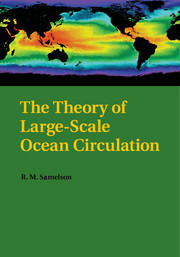Book contents
- Frontmatter
- Contents
- Preface
- 1 Basic Physical Principles and Equations
- 2 Reduced Equations for Large-Scale Motion
- 3 Planetary Geostrophic Vorticity Dynamics
- 4 Stratified Large-Scale Flow
- 5 Circulation in a Simple Rectangular Basin
- 6 Eddy-Driven Subsurface Motion
- 7 Circumpolar Flow
- 8 Mid-Depth Meridional Overturning
- 9 Thermohaline Effects
- 10 Theory and Observation
- Exercises
- References
- Index
2 - Reduced Equations for Large-Scale Motion
Published online by Cambridge University Press: 07 October 2011
- Frontmatter
- Contents
- Preface
- 1 Basic Physical Principles and Equations
- 2 Reduced Equations for Large-Scale Motion
- 3 Planetary Geostrophic Vorticity Dynamics
- 4 Stratified Large-Scale Flow
- 5 Circulation in a Simple Rectangular Basin
- 6 Eddy-Driven Subsurface Motion
- 7 Circumpolar Flow
- 8 Mid-Depth Meridional Overturning
- 9 Thermohaline Effects
- 10 Theory and Observation
- Exercises
- References
- Index
Summary
Scaling
As a model of the fluid motion and thermodynamics of the Earth's oceans, the basic equations (1.15)–(1.19) include a formidable array of distinct types of physical processes, from divergence of molecular diffusive fluxes on scales of millimeters to coherent fluid flow on the scales of the Earth's circumference, a range of space scales of order 1010. This range of scales is comparable to that between the molecular scale and the scale of a mammal's body. Thus, in a rough sense, the problem of using these equations to understand the large-scale structure of the ocean is comparable in difficulty to using numerical computations of molecular interactions to simulate the behavior of a mammal. Numerical solution of this full set of equations is thus well beyond current computational capacities and will remain so for the foreseeable futuremore. Furthermore, these equations are sufficiently challenging that fundamental mathematical properties, such as the existence and uniqueness of solutions, are not established. Some of these basic properties remain a subject of mathematical research even for the incompressible Navier-Stokes equations, a simplified set of four equations that may be obtained from (1.15) and (1.16) by replacing the density variable ρ with a constant value ρ0.
Despite these formidable challenges, it is possible to make progress by using a combination of mathematical and physical reasoning to derive simplified, or reduced, equation sets that describe motions on the largest space and time scales of interest.
- Type
- Chapter
- Information
- The Theory of Large-Scale Ocean Circulation , pp. 14 - 36Publisher: Cambridge University PressPrint publication year: 2011



